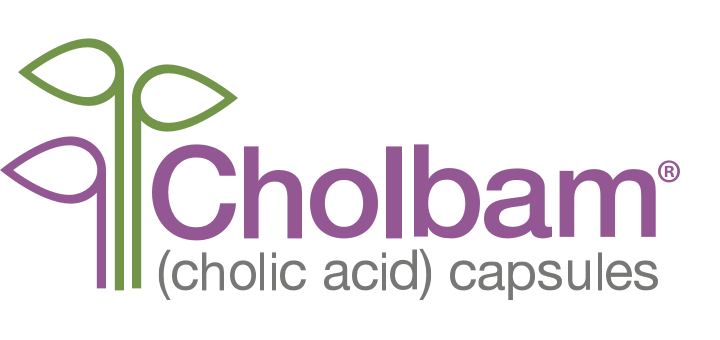
Frequently asked questions
About CHOLBAM® (cholic acid)
CHOLBAM is a bile acid indicated for:
- Treatment of bile acid synthesis disorders due to single enzyme defects.1
- Adjunctive treatment of peroxisomal disorders, including peroxisomal biogenesis disorder-Zellweger spectrum disorder (PBD‑ZSD), in patients who exhibit manifestations of liver disease, steatorrhea, or complications from decreased fat-soluble vitamin absorption.1
The safety and effectiveness of CHOLBAM on extrahepatic manifestations of bile acid synthesis disorders due to single enzyme defects or peroxisomal disorders, including PBD‑ZSD, have not been established.1
How does CHOLBAM work?
CHOLBAM capsules works by increasing cholic acid levels.1
The mechanism of action of cholic acid has not been fully established; however, it is known that cholic acid and its conjugates are endogenous ligands of the nuclear receptor, farnesoid X receptor (FXR). FXR regulates enzymes and transporters that are involved in bile acid synthesis and in the enterohepatic circulation to maintain bile acid homeostasis under normal physiologic conditions.1
CHOLBAM may improve bile flow and increase solubilization of dietary fats and fat-soluble vitamins through emulsification.2
CHOLBAM may help patients with SLOS1,*
Increase plasma cholesterol3,†
Increase in height and weight
- In a pivotal trial,‡ body weight increased by 10% or was stable at greater than the 50th percentile, among responders1
- Statistically significant improvements in height have been reported4
Lower liver enzymes1
- ALT or AST values reduced to less than 50 U/L, or baseline levels reduced by 80%
- Total bilirubin values reduced to less than or equal to 1 mg/dL
*No evaluable patients with SLOS were in the pivotal studies.
†In 11 of 12 patients with SLOS given CHOLBAM 10 mg/kg/day and cholesterol supplementation for 2 months, in an open-label, pilot study. Long-term studies are needed to determine durability of effect and possible clinical benefits.
‡Of other bile acid synthesis disorders due to single enzyme defects
ALT, alanine aminotransferase; AST, aspartate aminotransferase.
Why should I prescribe CHOLBAM?
CHOLBAM may increase serum cholesterol levels, lower liver enzymes, and increase height and weight in patients with Smith-Lemli-Opitz syndrome (SLOS).1,3,4
How do I dose CHOLBAM?
Starting dose of CHOLBAM for both children and adults should be based on weight. The recommended dose of CHOLBAM is 10 to 15 mg/kg once a day, which can be divided into 2 doses if necessary.1
Please see the CHOLBAM Prescribing Information for dose modification instructions for patients with newly diagnosed, or a family history of familial hypertriglyceridemia, treatment monitoring guidelines, and administration instructions.
How is CHOLBAM administered?
CHOLBAM should be taken with food. For infants and children who cannot swallow capsules, CHOLBAM capsules can be opened and mixed with either infant formula or breast milk (for younger children), or soft food such as mashed potatoes or apple puree (for older children and adults) in order to mask any unpleasant taste.1
What are potential adverse events with CHOLBAM?
In the CHOLBAM clinical trials,§ diarrhea was the most common adverse reaction in approximately 2% of the patient population. All other adverse reactions occurred in ≤1% of the patient population.1 See more safety information.
§Clinical safety experience with CHOLBAM consists of1
•ㅤㅤTrial 1: a non-randomized, open-label, single-arm trial of 50 patients with bile acid synthesis disorders due to SEDs and 29 patients with PDs including Zellweger spectrum disorders. Safety data are available over the 18 years of the trial.
•ㅤㅤTrial 2: an extension trial of 12 new patients (10 SED and 2 PD) along with 31 (21 SED and 10 PD) patients who rolled over from Trial 1. Safety data are available for 3 years and 11 months of treatment.
Adverse events were not collected systematically in either of these trials. Most patients received an oral dose of 10 to 15 mg/kg/day of CHOLBAM.
Smith-Lemli-Opitz Syndrome (SLOS)
What is SLOS?
SLOS results from an autosomal recessive mutation on the 7-dehydrocholestrol reductase (DHCR7) gene.5-7 Deficient activity of DHCR7 impairs the last step in cholesterol biosynthesis.8
Patients with SLOS under-produce cholesterol and struggle to absorb dietary cholesterol.5,9 When cholesterol production is low, toxic cholesterol precursors, 7-DHC (7-dehydroxcholesterol) and 8-DHC (8-dehydroxcholesterol), build up.8,9 Thus, low cholesterol levels and high concentrations of 7-DHC and 8-DHC are seen in patients with SLOS.5,9-11
Patients with SLOS can present with broad clinical manifestations.5,10,12 Clinical SLOS phenotypes may include major and minor malformations, including5,9:
1) Increased toxic cholesterol precursors 7-DHC and 8-DHC5,9,13
2) Decreases in cholesterol production and absorption, which can lead to8,14
– Interference with embryonic development via hedgehog signaling
– Altered vitamin D synthesis8,9
– Effects on cell membranes/myelin, lipid rafts5,8
– Deficiencies in steroid hormones, bile acids, and oxysterols5,9,15
3) Decreases in primary bile acids, which are critical for absorption of fat-soluble vitamins and absorption of cholesterol8,15-17
Low cholesterol also leads to a decrease in bile acids.6 Lower levels of bile acids may lead to poor nutrition and poor growth.15 Cholic acid supplementation enhances cholesterol absorption in humans.18
Patient Resources
What is the Mirum Access Plus Support Program?
Mirum Access Plus is available to help you, your office, and your patient not only get started with CHOLBAM after you’ve prescribed it, but also to provide support throughout treatment. Learn more about this valuable program.
If you have any questions about Mirum Access Plus, contact us at 1-855-MRM-4YOU (1-855-676-4968) Monday through Friday, 8:00 AM through 8:00 PM ET.
How do I enroll my patients?
If you’d like to prescribe CHOLBAM for your patient, download the Patient Enrollment Form. Once you have filled out the form and/or have your patient consent for Mirum Access Plus services, fax it to 1-855-282-4884.
REFERENCES: 1. CHOLBAM. Prescribing information. Mirum Pharmaceuticals, Inc. 2. Berendse K, Klouwer FCC, Koot BGP, et al. Cholic acid therapy in Zellweger spectrum disorders. J Inherit Metab Dis. 2016;39(6):859-868. doi: 10.1007/s10545-016-9962-9 3. Rizzo WB, Elias ER. Cholic acid increases plasma cholesterol in Smith-Lemli-Opitz syndrome: a pilot study. Poster presented at: SSIEM Annual Symposium 2023; August 19-September 1, 2023; Jerusalem, Israel. Poster B273. 4. Gonzales E. Gerhardt MF. Fabre M. et al. Oral cholic acid for hereditary defects of primary bile acid synthesis: a safe and effective long-term therapy. Gastroenterology. 2009:137(4):1310-1320. doi: 10.1053/j.gastro.2009.07.043 5. Porter FD. Smith-Lemli-Opitz syndrome: pathogenesis, diagnosis and management. Eur J Hum Genet.2008;16(5):535-541. doi: 10.1038/ejhg.2008.10 6. Tint GS, Irons M, Elias ER, et al. Defective cholesterol biosynthesis associated with the Smith-Lemli-Opitz syndrome. N Engl J Med. 1994;330(2):107-113. doi: 10.1056/NEJM199401133300205 7. Jezela-Stanek A, Siejka A, Kowalska EM, Hosiawa V, Krajewska-Walasek M. GC-MS as a tool for reliable non-invasive prenatal diagnosis of Smith-Lemli- Opitz syndrome but essential also for other cholesterolopathies verification. Ginekol Pol. 2020;91(5):287-293. doi: 10.5603/GP.2020.0049 8. DeBarber AE, Eroglu Y, Merkens LS, Pappu AS, Steiner RD. Smith-Lemli-Opitz syndrome. Expert Rev Mol Med. 2011;13:e24. doi: 10.1017/S146239941100189X 9. Griffiths WJ, Abdel-Khalik J, Crick PJ, et al. Sterols and oxysterols in plasma from Smith-Lemli-Opitz syndrome patients. J Steroid Biochem Mol Biol. 2017;169:77-87. doi: 10.1016/j.jsbmb.2016.03.018 10. Ballout, RA. Smith-Lemli-Opitz Syndrome (SLOS). In: Rezae, N, eds. Genetic Syndromes. Springer, Cham. 2021. https://-doi.org/10.1007/978-3-319-66816-1_501-1 11. Kelley RI, Hennekam RC. The Smith-Lemli-Opitz syndrome. J Med Genet. 2000;37(5):321-135. doi: 10.1136/jmg.37.5.321 12. Steiner RD, Rohena LO. Smith-Lemli-Opitz Syndrome. Medscape. Updated September 24, 2021. Accessed January 4, 2023. https://emedicine.medscape.com/article/949125-print 13. Shefer S, Salen G, Batta AK, et al. Markedly inhibited 7-dehydrocholesterol-delta 7-reductase activity in liver microsomes from Smith-Lemli-Opitz homozygotes. J Clin Invest. 1995;96(4):1779-1785. doi: 10.1172/JCI118223 14. Ying L, Matabosch X, Serra M, Watson B, Shackleton C, Watson G. Biochemical and physiological improvement in a mouse model of Smith-Lemli-Opitz Syndrome (SLOS) following gene transfer with AAV vectors. Mol Genet Metab Rep. 2014;1:103-113. doi: 10.1016/j.ymgmr.2014.02.002 15. Honda A, Salen G, Shefer S, et al. Bile acid synthesis in the Smith-Lemli-Opitz syndrome: effects of dehydrocholesterols on cholesterol 7alpha-hydroxylase and 27-hydroxylase activities in rat liver. J Lipid Res.1999;40(8):1520-1528. 16. Staels B, Fonseca VA. Bile acids and metabolic regulation: mechanisms and clinical responses to bile acid sequestration. Diabetes Care. 2009;32 Suppl 2(Suppl 2):S237-S245. doi: 10.2337/dc09-S355 17. Schmidt DR, Holmstrom SR, Fon Tacer K, Bookout AL, Kliewer SA, Mangelsdorf DJ. Regulation of bile acid synthesis by fat-soluble vitamins A and D. J Biol Chem. 2010;285(19):14486-14494. doi: 10.1074/jbc.M110.116004 18. Woollett LA, Buckley DD, Yao L, et al. Cholic acid supplementation enhances cholesterol absorption in humans. Gastroenterology. 2004;126(3):724-731. doi: 10.1053/j.gastro.2003.11.058
INDICATION
CHOLBAM® (cholic acid) is a bile acid indicated for- Treatment of bile acid synthesis disorders due to single enzyme defects.
- Adjunctive treatment of peroxisomal disorders, including Zellweger spectrum disorders, in patients who exhibit manifestations of liver disease, steatorrhea, or complications from decreased fat-soluble vitamin absorption.
LIMITATIONS OF USE
The safety and effectiveness of CHOLBAM on extrahepatic manifestations of bile acid synthesis disorders due to single enzyme defects or peroxisomal disorders, including Zellweger spectrum disorders, have not been established.IMPORTANT SAFETY INFORMATION
WARNINGS AND PRECAUTIONS – Exacerbation of liver impairment
- Monitor liver function and discontinue CHOLBAM in patients who develop worsening of liver function while on treatment.
- Concurrent elevations of serum gamma glutamyltransferase (GGT) and alanine aminotransferase (ALT) may indicate CHOLBAM overdose.
- Discontinue treatment with CHOLBAM at any time if there are clinical or laboratory indicators of worsening liver function or cholestasis.
ADVERSE REACTIONS
- The most common adverse reactions (≥1%) are diarrhea, reflux esophagitis, malaise, jaundice, skin lesion, nausea, abdominal pain, intestinal polyp, urinary tract infection, and peripheral neuropathy.
DRUG INTERACTIONS
- Inhibitors of Bile Acid Transporters: Avoid concomitant use of inhibitors of the bile salt efflux pump (BSEP) such as cyclosporine. Concomitant medications that inhibit canalicular membrane bile acid transporters such as the BSEP may exacerbate accumulation of conjugated bile salts in the liver and result in clinical symptoms. If concomitant use is deemed necessary, monitoring of serum transaminases and bilirubin is recommended.
- Bile Acid Binding Resins: Bile acid binding resins such as cholestyramine, colestipol, or colesevelam adsorb and reduce bile acid absorption and may reduce the efficacy of CHOLBAM. Take CHOLBAM at least 1 hour before or 4 to 6 hours (or at as great an interval as possible) after a bile acid binding resin.
- Aluminum-Based Antacids: Aluminum-based antacids have been shown to adsorb bile acids in vitro and can reduce the bioavailability of CHOLBAM. Take CHOLBAM at least 1 hour before or 4 to 6 hours (or at as great an interval as possible) after an aluminum-based antacid.
PREGNANCY
No studies in pregnant women or animal reproduction studies have been conducted with CHOLBAM.LACTATION
Endogenous cholic acid is present in human milk. Clinical lactation studies have not been conducted to assess the presence of CHOLBAM in human milk, the effects of CHOLBAM on the breastfed infant, or the effects of CHOLBAM on milk production. The developmental and health benefits of breastfeeding should be considered along with the mother’s clinical need for CHOLBAM and any potential adverse effects on the breastfed infant from CHOLBAM or from the underlying maternal condition.GERIATRIC USE
It is not known if elderly patients respond differently from younger patients.HEPATIC IMPAIRMENT
- Discontinue treatment with CHOLBAM if liver function does not improve within 3 months of the start of treatment.
- Discontinue treatment with CHOLBAM at any time if there are clinical or laboratory indicators of worsening liver function or cholestasis. Continue to monitor laboratory parameters of liver function and consider restarting at a lower dose when the parameters return to baseline.

